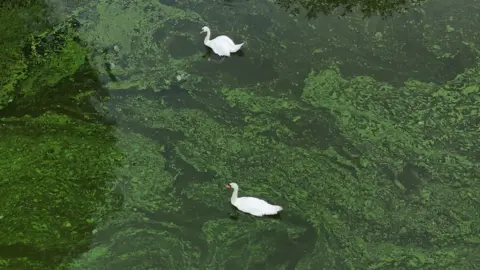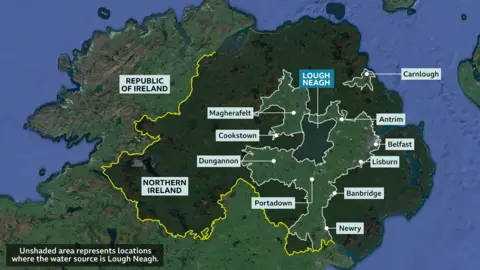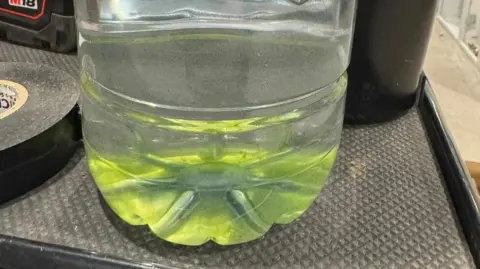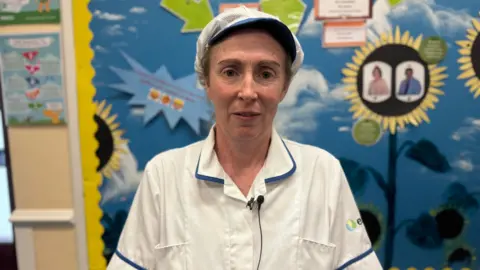Tap water is 'rank and mouldy', say residents
 Chris Ennion
Chris EnnionResidents in parts of Mid-Ulster say their tap water has a "rank" and "mouldy" taste.
People in Magherafelt, Castledawson, Draperstown, Ballinderry and Cookstown have noticed the issues with water.
NI Water said the smell and taste were produced by naturally occurring compounds related to algae in Lough Neagh were not harmful to health.
However, NI Water has not confirmed to BBC News NI how many customers and what areas are affected.
 PA
PAChris Ennion, who lives in Maghera, said he was now giving his little boy bottle water instead of tap water.
He accused the company of having a "terrible attitude" in their response.
"I don't think because they're saying it's safe they shouldn't do anything about it. I don't think leaving our water source in that sort of state is acceptable," he said.
"I'd like to know if the people that are making those decisions are drinking the water themselves.
"It's just not pleasant, and if the water's warm, it's worse, so if you're showering you can smell a mould smell, which is disgusting."
In their statement, NI Water said: "This smell and taste is related to algae levels in Lough Neagh and naturally occurring compounds found in beetroot and soil."
In response, Mr Ennion said: "I don't want a glass of beetroot."
'I've felt pretty rubbish'
The Maghera resident said the water gets worse when it's sunny.
"It doesn't seem to be a constant thing, like it's noticeable, but it seems to be after we've had really good weather," he said.
Although Mr Ennion has stopped giving the tap water to his son, he is still drinking it because NI Water says it's safe.
"For the last week, I'd say, I've felt pretty rubbish, so I don't know if that's related or not," he said.

'Tasted like poison'
 Emmett McNally
Emmett McNally Residents living in the affected areas have commented on the water on community pages on Facebook with one describing it as tasting "rank" and another "rotten".
Magherafelt resident Lauren McCulla told BBC News NI's The Nolan Show that after seeing comments she tried her own tap water and "was shocked".
She said she usually drinks water which is filtered through her fridge, and when she compared it to the tap water she said the latter "tasted like poison".
"It was like stagnant, mouldy water.
"You couldn't give it to your child and expect them to drink it.
"Why is my fridge able to filter it and they can't?" she added.
In response, the head of drinking water regulation at NI Water, Dymphna Gallagher, told the programme: "We can reassure customers of the safety of their drinking water, even though it does taste and it does smell.
"I wouldn't want to drink water that has an earthy and musty taste, but it is safe," she added.
"We have a robust nine-stage treatment works" which is "optimised because of the algae in the lough" meaning that the difference in the water that is in Lough Neagh and the water that comes from the tap “is massive”.
'Problem with coffee filters'
Johnnie Finch, a businessman who lives in the village of Coagh in County Tyrone, near the shores of Lough Neagh, said he had an issue with water for the last year, but it was "particularly bad at the minute".
“The water is coming through very discoloured and there's a definite bad taste, a real mustiness to it. The kids simply won’t drink it.
“It’s now got to the point where we filter everything we use and we’ve been buying a lot of bottled water.
“But even when you filter the water, we’re still getting that same musty taste."
Mr Finch also has two businesses near Cookstown which have coffee machines and he is worried they have been affected.
“Recently, I’ve noticed a real problem with the filters, they need changed more often, much more than other sites I have outside Mid-Ulster."

Eileen Watson works in the kitchen of St Eoghan’s primary school in Moneyneena.
She said: "There’s something not right with the water, a strong mouldy smell, the kids simply don’t want to drink the water we’re supplying from the taps.'
“It’s all well and good NI water saying it’s not damaging for your health, but at the end of the day if food smelt bad but you were being told the date was fine, would you eat it?
"I don’t think it’s an acceptable situation.”

SDLP Mid Ulster MLA Patsy McGlone told The Nolan Show that he is "getting complaints right throughout the constituency about the smell and indeed the taste" of the water.
"I'm concerned that a number of residents have asked NI Water to take samples, and they have responded saying that they were not going to do that.
"Surely, that would be a primary issue for them, to reassure the public that what they are consuming is safe."
In a previous statement, NI Water said they would like to "reassure" customers that their priority is the quality and safety of the drinking water they provide.
"We are aware that a small number of customers have been reporting a taste and smell in their drinking water supply.
“NI Water is confident there is no water quality issue in relation to the drinking water produced by the Water Treatment Works that abstract water from Lough Neagh."
On Friday evening, NI Water sent an updated statement suggesting that "storing tap water in the fridge before use may improve the taste and smell".
It added that affected areas included "Mid Ulster and some areas of Portadown, Lurgan and Dungannon".
The NI Environment Agency said its Drinking Water Inspectorate (DWI) was investigating.
"The water treatment works that extract water from Lough Neagh are designed for the removal of algae that may be present in the raw water," it said.
"The drinking water regulations set standards for a range of microbiological and chemical parameters.
"NI Water monitor these parameters at water treatment works, service reservoirs and consumer taps to ensure compliance with the regulations. "
'Smell of blue mould'
The MLA for Mid Ulster, Emma Sheerin, has called on NI Water to provide the area with bottled water in the interim.
“Where I represent in south Derry, this issue seems to be very prevalent, particularly in Ballynascreen, Moneyneena and across to Magherafelt.'
“I first noticed this on my own about two or three weeks ago, like a smell of blue mould in the water, and I literally couldn’t drink the water out of the tap, it’s just getting stronger.”
What is blue-green algae?
Blue-green algae, technically known as cyanobacteria, is a collection of microscopic organisms that are naturally present in lakes and streams.
Under certain conditions, blue-green algae can become abundant in warm, shallow, undisturbed, nutrient-rich surface waters that receive a lot of sunlight.
When this occurs, the algae can form blooms that discolour the water or produce floating mats or scums on the water’s surface.
Blue-green algae returned to Lough Neagh in high levels earlier this year.
Lough Neagh is the largest body of fresh water in the British Isles.
The lough supplies half of Belfast's drinking water and 40% of Northern Ireland's overall.
